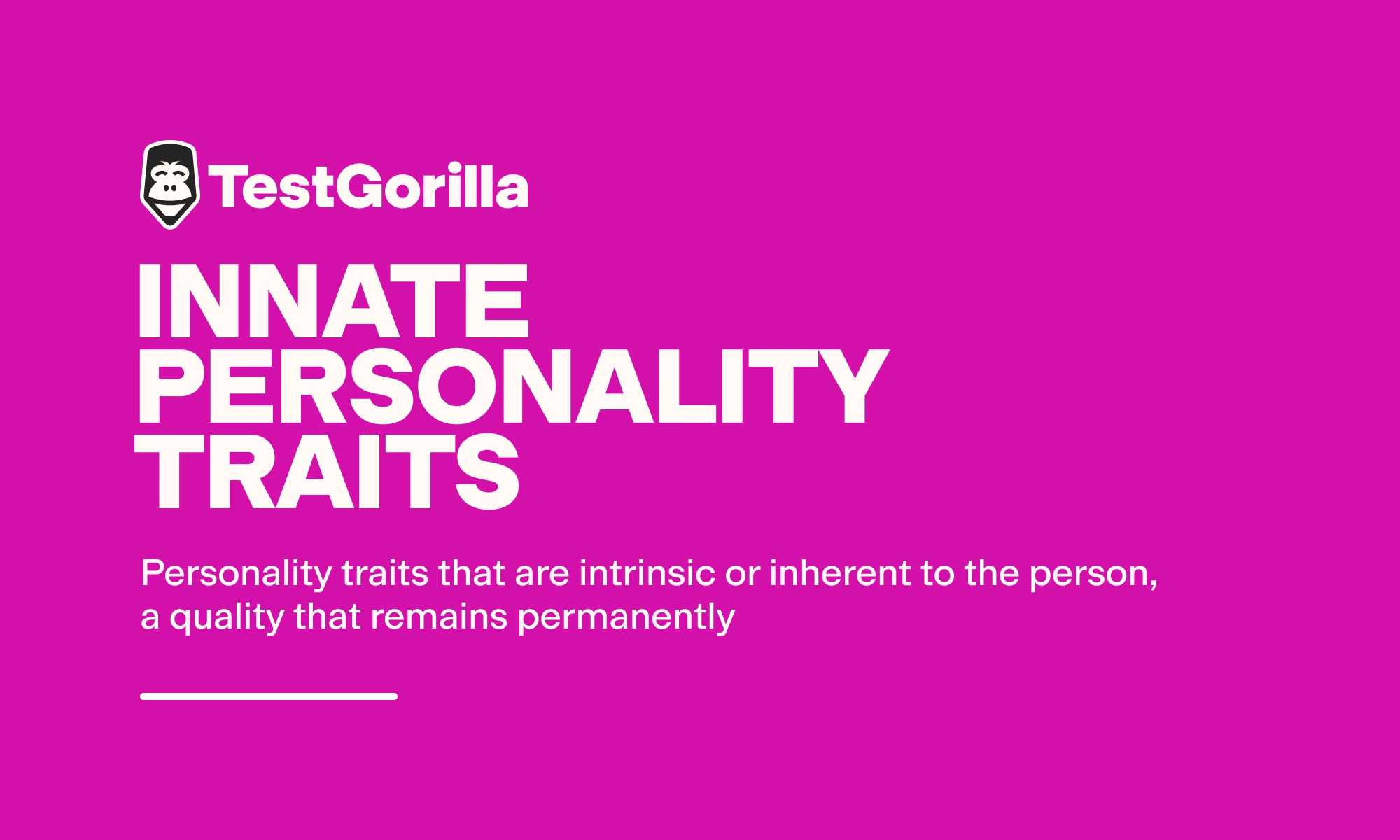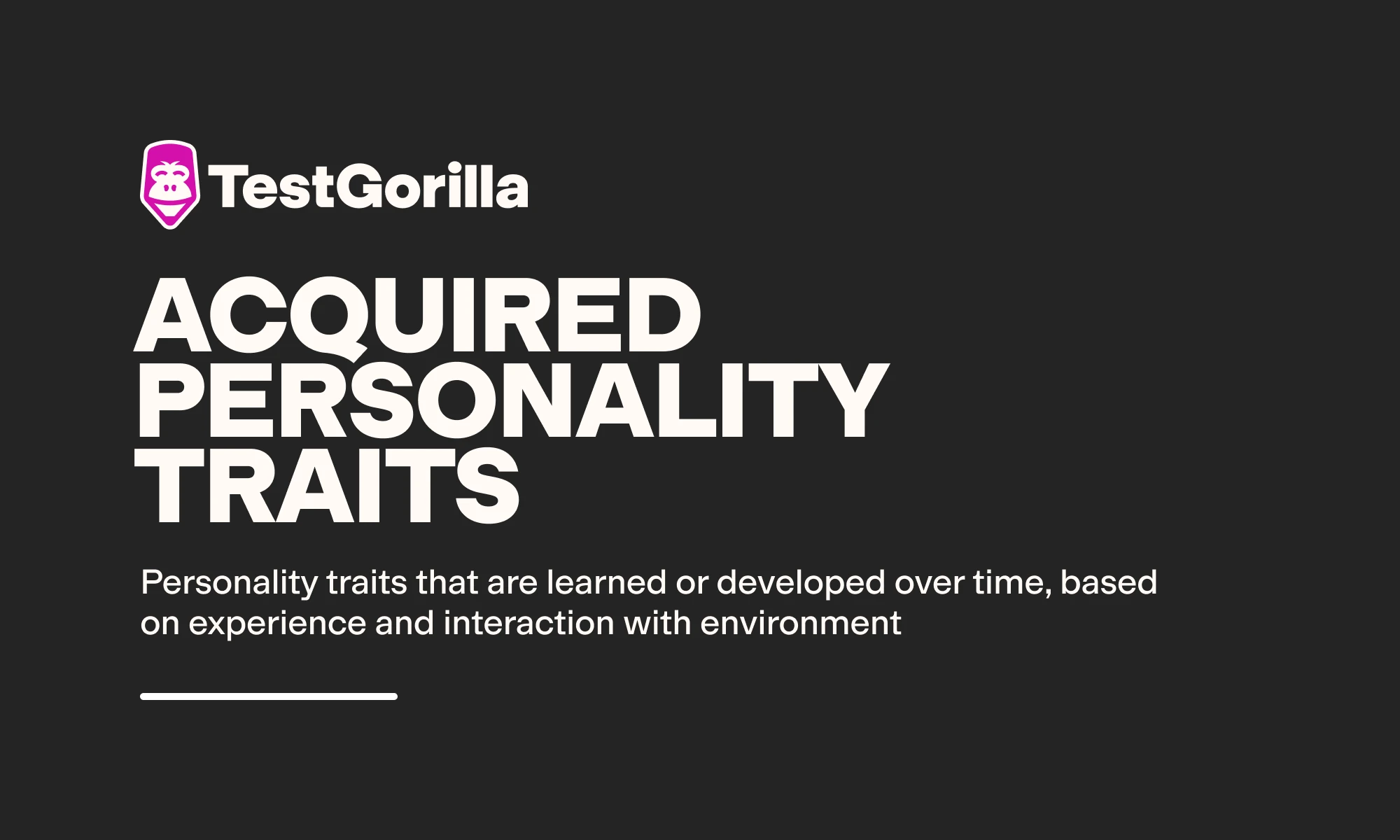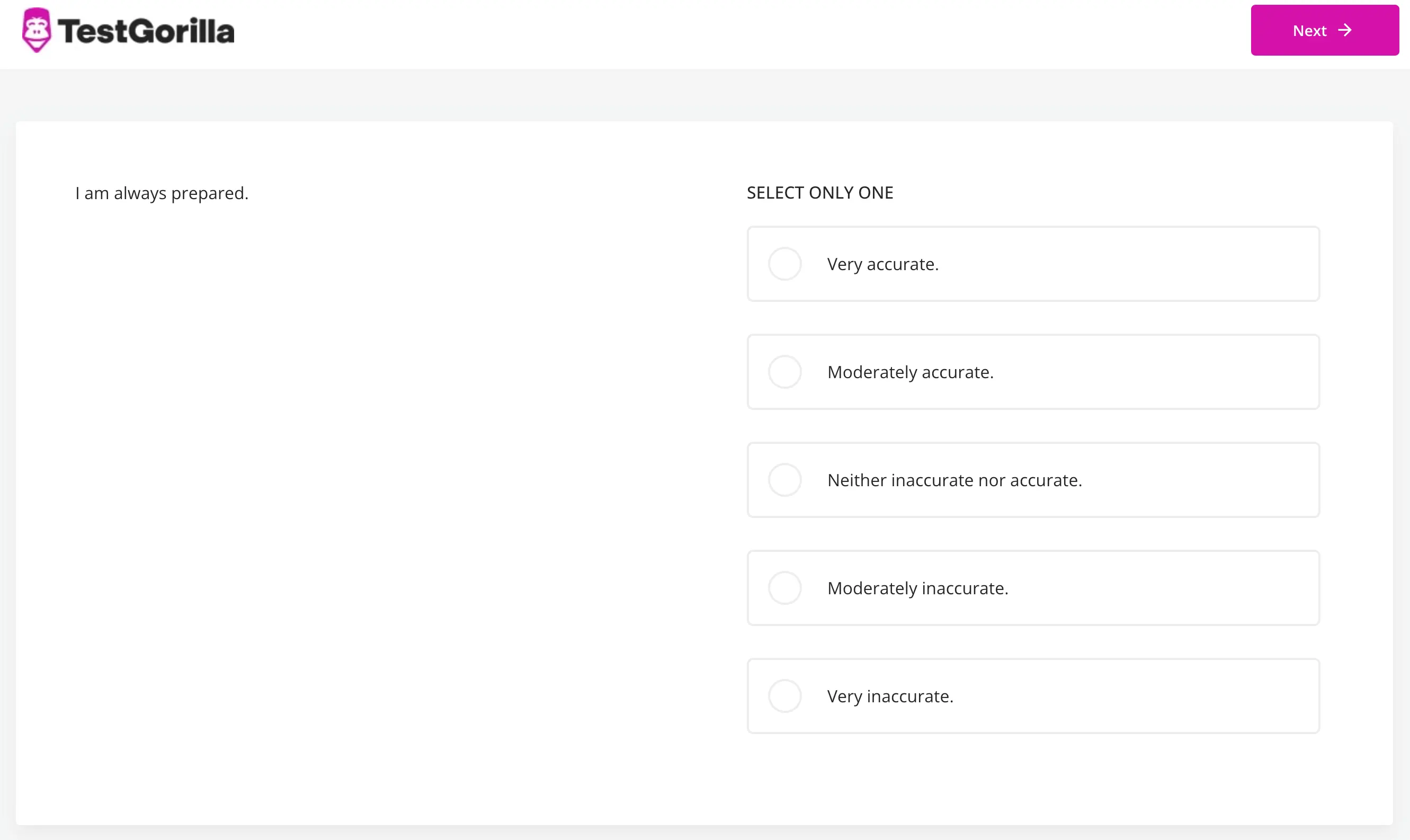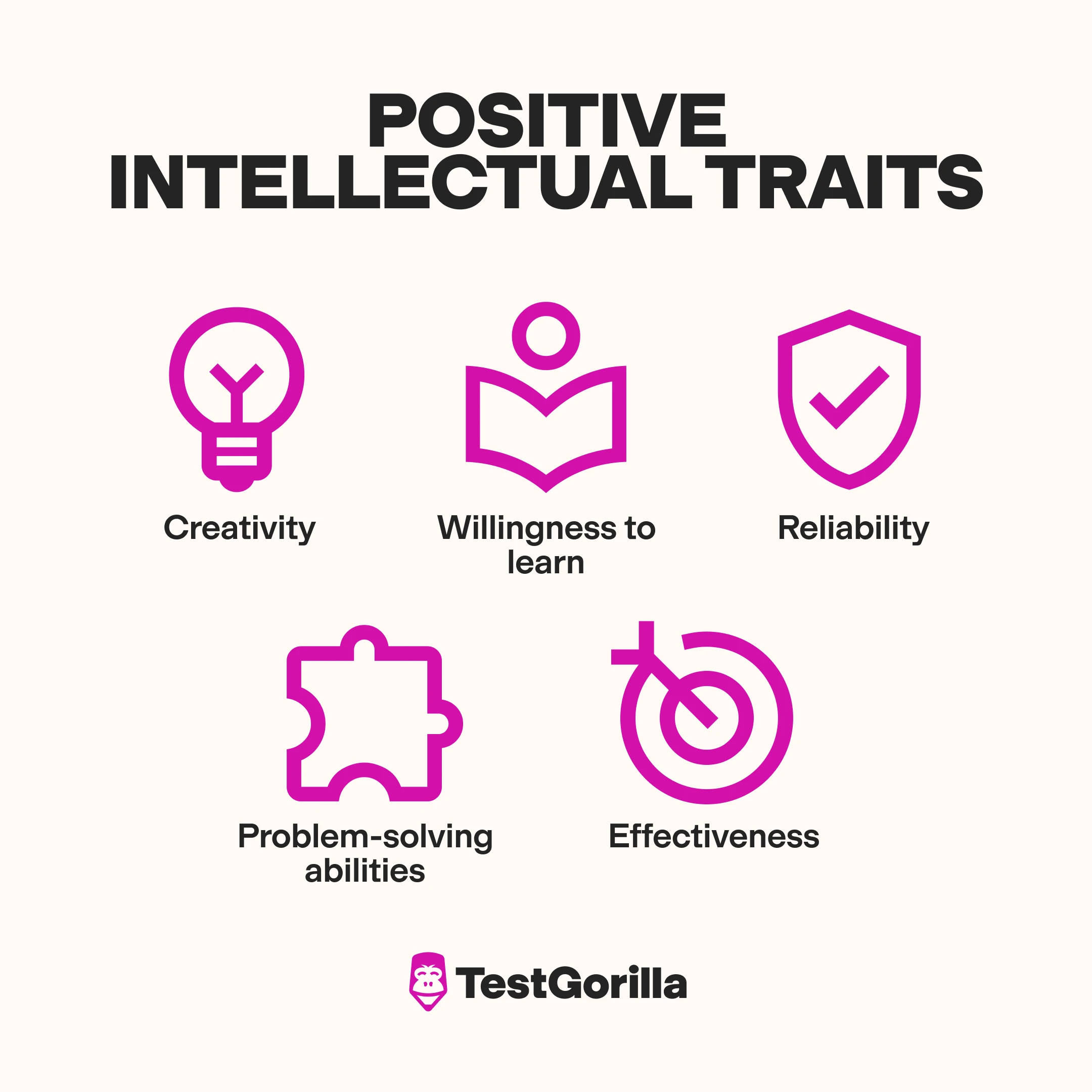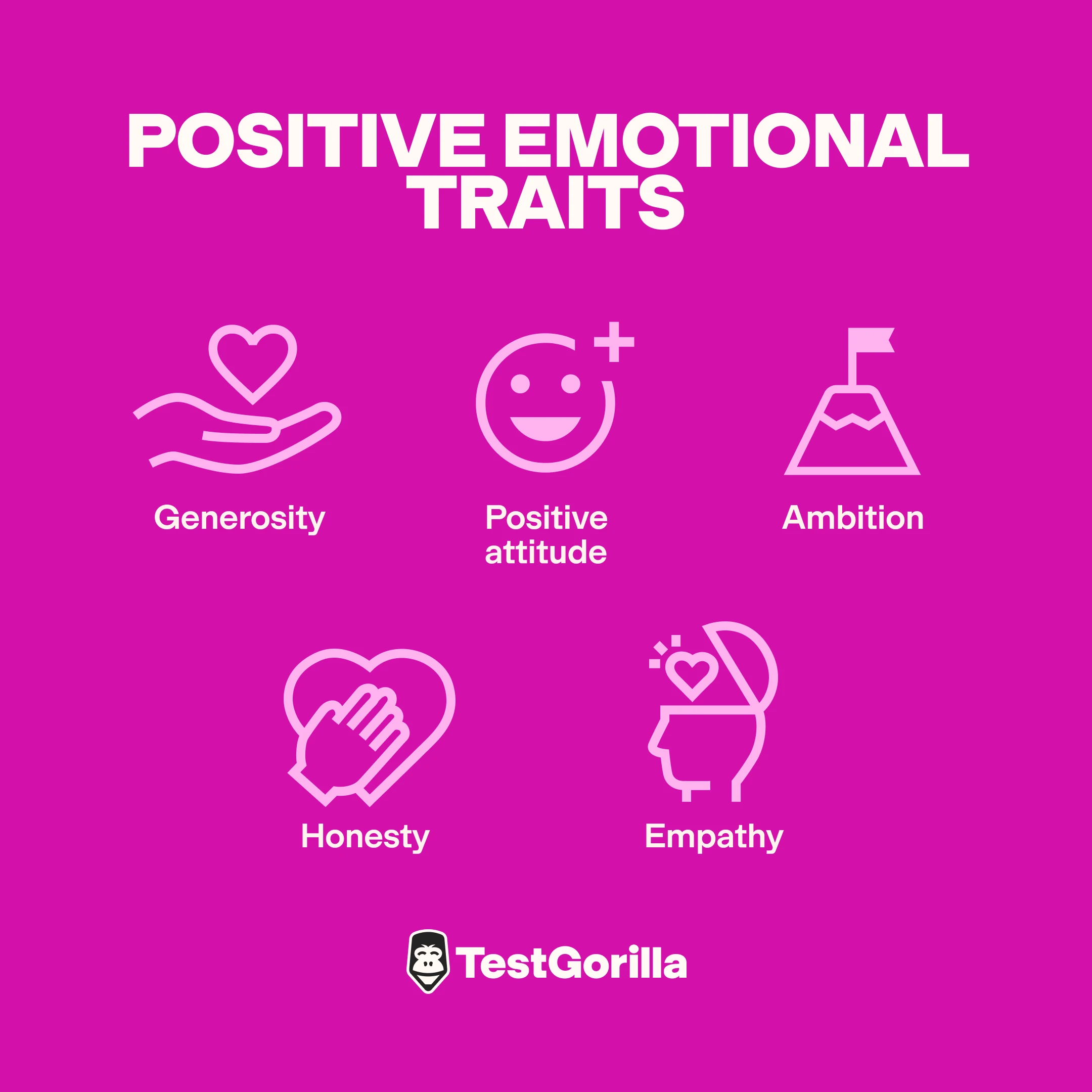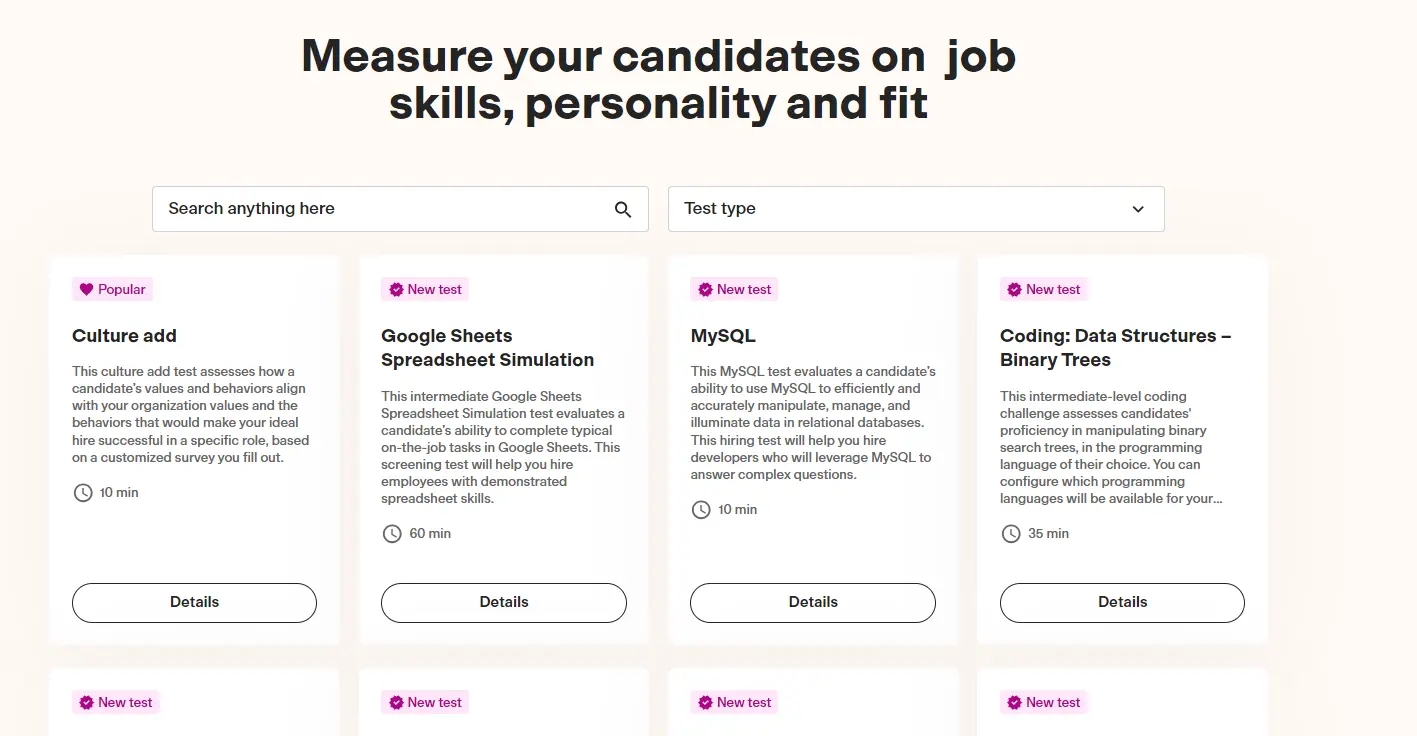Acquired vs innate personality traits in the workplace
Hire with confidence and find the perfect fit with TestGorilla
When hiring a new employee in today’s marketplace, the first thing you do is write a list of qualities that you want to see in prospective candidates.
You know: skills, knowledge, attitude, characteristics, etc., that would make your candidate a great asset to your organization.
Even though you set the bar high, you also need to be realistic and understand that you may not always find the perfect candidate — the person who ticks every single box on your list.
So on your list, you divide between good-to-have qualities and must-have qualities.
Sometimes your selected candidate will miss out on some good-to-have attributes, and you’ll need to see if you can teach them to your new employee.
There are two types of qualities: innate personality traits and acquired character traits. It’s important to understand and work with both of these.
With that in mind, this article will cover the difference between innate personality and acquired traits, the reasons why a test is the best way to differentiate between them, and some of the positive and negative characteristics you need to be aware of when hiring an applicant.
Table of contents
What are innate personality traits?
Innate personality traits are intrinsic or inherent to the person, a quality that remains permanently in your candidate. Therefore, a candidate that goes through a personality test at 30 will likely get almost the same results twenty years later.
For example, if you hire a reserved and solitary individual, they’re unlikely to become outgoing and energetic over time.
Sometimes a candidate can display specific behaviors in one moment that aren’t part of their innate personality. Environmental factors, stress, and general well-being can influence someone to act in a certain way in a particular situation, but that doesn’t mean they will behave like that for the entirety of their careers.
Personality tests and cognitive aptitude tests: Why it matters in the workplace
One fairly consistent quality across a person’s life is cognitive aptitude. Cognitive aptitude is a quality that defines:
Critical-thinking skills
Problem-solving skills
Adapting and learning new information
Attention to detail
Cognitive ability is also one of the best predictors of long-term job performance. So when you’re hiring for your organization, you should test candidates’ cognitive traits to see if they’re a good match.
On top of cognitive ability tests, personality tests used in the hiring process measure the innate qualities of the candidates. The pre-employment tests you use to measure cognitive abilities and personality traits help you assess the candidates and analyze which one best fits your company and team.
We’ll discuss personality tests further below. But before we do, let’s have a look at acquired traits.
While innate qualities are relatively constant and consistent throughout a person’s lifetime, acquired traits are those things that (can) change within the employee.
What are acquired personality traits?
Acquired traits include things such as:
Skills
Knowledge
Characteristics
Acquired traits are learned or developed over time, and they’re based on the candidate’s interaction with their environment and experience. Applicants aren’t born with these qualities, and such traits can change over time in candidates.
For example, no person is born with the skills to be a JavaScript developer, Construction manager, or an Electrician.
People can have inclinations toward a particular field or possess certain innate traits that give them a better starting point.
Someone can be really tall, making them more inclined to start practicing basketball, for which height is an advantage. Or someone can have excellent hand-eye coordination, which may make them inclined to become a surgeon.
But most acquired traits are picked up through life experience and a combination of practice, exposure, time, and dedication.
Defining character and why it matters in the workplace
You can assess acquired traits in a plethora of ways.
When you look at a candidate’s CV, you see information that tells you about their acquired qualities, skills, knowledge, and experience.
For example, a CV can let you know that the candidate has experience leading a team in a particular industry, which means they have some leadership and people management skills. The CV can also tell you an applicant spent the first 18 years of their life living in Sweden, and that’s why they’re fluent in Swedish.
All these things provide evidence that the person dedicated a certain amount of time, experience, and practice to acquire those qualities and traits.
You can assess acquired skills from a candidate in an interview, but the more effective option is to give the candidate a pre-employment test to verify claims in the resume. Skills assessments can even help you evaluate acquired soft skills such as:
Innate personality traits vs acquired character traits
There’s a difference between personality and character.
Personality falls under the innate traits a person has, and it’s mostly stable and unchangeable throughout their life.On the other hand, a person’s character is acquired and shaped through a combination of skills, experience, attitude, habits, daily rituals, and general mindset about life and business.
Personality is innate; character is acquired. Personality is mostly the same for the entirety of a person’s life, while character can change.
Both are important factors to consider in the workplace, and you need to evaluate, assess, and verify both when it comes to selecting candidates. However, they provide different information to the HR team.
Innate personality traits generally predict a candidate’s job performance over the long term. Personality tests and cognitive ability tests fare best here. An employee can have great problem-solving skills, which means that the employee could be a great manager to lead people through uncertain times and find solutions to the problems faced.
Innate qualities also help the recruiter understand where the candidate would fit best in a company. A stoic, math-oriented individual who pays attention to even the smallest details wouldn’t do well in a sales team’s hectic, fast-paced environment. But they could do wonders in an accounting team that relies heavily on organization, structure, analytics, and detail orientation.
On the other hand, an extroverted candidate with excellent verbal reasoning skills, natural charisma, and negotiation skills would do exceptionally well in a sales team but not so well in an accounting team.
Because innate traits are lifelong, you should consider them carefully and put people into teams where they’ll thrive best. This will also ensure their job satisfaction and, in turn, provide better results.
Acquired traits are things a person has picked up over their life that weren’t present from birth. They don’t indicate the individual’s capacity and potential, but they show the candidate’s acquired skills.
So when you’re looking for a candidate well-versed in using Microsoft Azure, you need someone who knows how to use those tools now. But if a person knows Microsoft Azure, it doesn’t mean they’ll be able (or dedicated) to learn Python, TypeScript, or Ruby in a year’s time.
A better indicator for learning something new is a person’s general (cognitive) aptitude (an innate personality trait). We’ll look at some personality tests to assess these inherent personality traits, especially the OCEAN model.
OCEAN model and the 4-letter type test
Personality tests can measure candidates’ inclinations as scale-based or profile-based.
Take, for example, the 4-letter type test, which has four areas and eight categories:
Extroversion/Introversion
Sensing/Intuition
Thinking/Feeling
Judgment/Perception
This personality test is a profile-based assessment that places you into one or another category, even though most of the population exists on a continuum (i.e., with a percentage of this or that).
You’re either an introvert or an extrovert with a profile-based test, but a scale-based test indicates you’re this much introverted or that much extroverted. It’s like a test that tells you if you’re skinny or overweight, rich or poor, tall or short, even though most of the population is somewhere in the middle.
With the OCEAN test (preview below), you will get the scale-based result that can provide you with more information necessary for the workplace.
OCEAN stands for Openness, Conscientiousness, Extroversion, Agreeableness, Neuroticism.
Each category determines a specific trait about the individual:
Openness. This is related to the candidate’s affection toward novelty. Those with high scores will more likely be adventurous and creative, while those with low scores prefer routines and are more conservative. The traits in this category determine the person’s imagination, feelings, actions, ideas, and values.
Conscientiousness. This is related to how well a person can control and direct their impulses. Those with high scores can be marked as motivated and disciplined, while those with low scores are often described as casual, laid-back, and relaxed. The traits in this category determine the person’s order, self-discipline, and competence.
Extroversion. This is related to how friendly, cheerful, and communicative the candidate is. High scores usually indicate that the person is sociable, while low scores indicate a more introverted person, more likely to follow instructions and authority. The traits in this category determine the person’s warmth, friendliness, assertiveness, and positive emotions.
Agreeableness. This is related to how a person interacts with people around them. A high score shows that someone is warm and friendly. Those with lower scores tend to be less trusting and more inclined to start a conflict. The traits in this category determine the person’s trust, compliance, modesty, sympathy, and cooperation.
Neuroticism. This is related to the person’s emotional stability and anxiety levels. High scores tend to show a person lacking self-confidence, while low scores describe an assured, calm, and confident. The traits in this category determine the person’s hostility or friendliness level, anger levels, self-consciousness, vulnerability, and emotional stability.
Pros & cons of the OCEAN model
Every test and model has its pros and cons, and the OCEAN model isn’t an exception.
The OCEAN model doesn’t try to shoehorn people into a particular profile but locates the person’s qualities on a spectrum. This is good because it provides more accurate detail. Someone can be 57% extroverted, meaning they’re only slightly extroverted.
The OCEAN model (or Big Five) gives the recruiter plenty of flexibility over where to put the person in the organization so they can thrive.
When it comes to cons, the test gives out the big-picture view of the individual, but that doesn’t help very much when it comes to determining and predicting specific behaviors a person will do in a particular environment. A test like the 4-letter type test or Enneagram is better at this than OCEAN.
Match skills & culture: Start building your dream team with TestGorilla.
Examples of positive and negative characteristics
We’ve covered the personality tests and the differences between innate and acquired traits, so let’s look at what that specifically means for the workplace.
The following is a list of positive and negative characteristics that a candidate can display during the hiring process that you should notice as a hiring manager.
There are three main sets of characteristics which can either be positive or negative:
Interpersonal characteristics
Intellectual characteristics
Emotional characteristics
Positive interpersonal characteristics
The following are the positive interpersonal characteristics in the workplace:
1. Teamwork
Great ideas don’t come to lone geniuses but to those who work together in a team. A candidate needs to show they can work with others because it’s essential for the success of the individual and the team.
Teamwork provides multiple benefits to all stakeholders involved:
Diverse perspectives from different team members can provide solutions to a given problem faster
There’s a higher sense of meaning when the individual team members lose the “I” and start working for “we”
Working in a cohesive team helps team members feel less stressed, happier, and more productive
2. Conflict resolution
Conflict resolution means that two or more parties can find a peaceful solution to a conflict, disagreement, or feud. A candidate with good conflict resolution skills can be a great asset to any team.
Whenever you have different perspectives and backgrounds, it’s only a matter of time before a conflict arises. So it pays off to have a team member who can lead two (or more) parties through the resolution process.
3. Integrity
Integrity is a multi-faceted characteristic. A candidate who displays integrity does so toward themselves, others, and the organization. The applicant needs to demonstrate integrity with their actions so that other team members can trust and rely on them.
The candidate needs to be sound and incorruptible and to follow through on their words with actions. A candidate’s integrity usually stems from a solid moral and ethical code of conduct.
4. Professionalism
A professional candidate will show that others can rely on them. Not only that — the candidate will display a high standard for themselves and others, they’re always presentable toward all shareholders and stakeholders, and they do this even when nobody’s watching.
A professional candidate will be knowledgeable, competent, and respectful to his colleagues and peers.
5. Leadership
Leadership is an essential characteristic for candidates. It’s defined as the ability of the individual to direct, influence, and guide other members of the organization.
Leadership isn’t about having followers but empowering other people to become leaders. So take notice when you encounter a candidate displaying leadership qualities and traits because they could be a great addition to your company. Other team members will respect someone with good leadership qualities, so a candidate with such skills could influence them.
A leader doesn’t have to be a manager: leadership isn’t a position but a role a person fills.
Positive intellectual traits
The following are the positive intellectual characteristics in the workplace:
1. Creativity
Creativity is defined as an inclination that helps individuals generate and recognize ideas, possibilities, and alternative options to solve problems, communicate with others, or even entertain people.
Creative candidates can help out themselves and their team members by coming up with innovations, looking at the problem from a different angle and perspective, and finding a way to make the experience pleasant for everyone involved.
2. Willingness to learn
In this ever-changing world and even faster-changing workplace, candidates must have the ability and willingness to change and learn new things. It’s not just that the candidate needs to know how to learn new things, but they also need to be able to unlearn old things and replace them with new knowledge and skills.
A candidate that shows a willingness to learn is a candidate that will adapt their skills over time and never have an outdated skillset.
3. Reliability
A candidate who says what they’ll do and then do it shows that other team members can rely on that person. This is an essential trait for every team member because reliability creates trust.
How can you trust a team member to do their job if you know they’re not reliable? You can’t. A team is only as strong as its team members, and you need a team of reliable individuals who can pull their weight.
4. Problem-solving abilities
With the fast pace in the workplace, it’s only a matter of time until problems arise. So you’ll need employees who’ll look at the situation and figure out a solution as soon as possible, instead of complaining or “passing on the hot potato.”
A candidate with problem-solving skills will come to the manager with solutions, not problems, and they’re extremely valuable as a member of any team. So when you find an applicant with problem-solving abilities, know that you have a potentially great candidate.
5. Effectiveness
A great applicant will show their effectiveness throughout the hiring process and, if hired, will continue to be productive both as an individual with their own performance indicators and as a member of the team.
An effective candidate will be a productive team member who’ll continually hit their goals and help others do the same.
Positive emotional traits
The following are the positive emotional characteristics in the workplace:
1. Generosity
A candidate needs to be able to create a comfortable and friendly workspace that provides a sense of camaraderie and community. So when you find a generous applicant, know that you have a candidate who’ll make sure that the team works for “we” instead of “I.”
A generous person gives back to others even in the workplace, and they do so by lending their skills to others, being there to listen, and giving people encouragement and their time. And the best thing is that they do this without expecting anything in return.
2. Positive attitude
A candidate who displays a positive “yes we can” attitude will bring lots of good energy to the team and the organization. Sometimes, team members need encouragement and help to see the good sides, especially when problems pile up. In these situations, a team member with a positive attitude can work wonders.
So test your candidates to see if they’ll bring a positive attitude to the teams where they’d work.
3. Ambition
The workplace is changing, and many new roles are emerging that didn’t even exist 10 or 15 years ago. Many new opportunities will open up with this change, and you’ll need candidates ambitious enough to take them.
But this is needed not only for new positions. Every C-level executive once started from the ground floor in a company, and you might have just given a pre-employment test to the future CEO of your company.
4. Honesty
Your organization hires employees not only for their skills but also for who they are as people, what they value, and what they strive for in the future. Your company has goals, vision, mission, and values, and you want your employees to align with those.
So you need to test your candidate to see if they’re honest and if they really believe in the things they discuss.
5. Empathy
Empathy is the ability of someone to feel what the other person is feeling, to put themselves in their shoes. To do this, the person will have to look at things from someone else’s perspective to understand what they feel.
A candidate with empathy can do wonders for a team. They’re great listeners, they can mend bridges between people, and they’ll be a force bringing people together instead of separating them.
Negative interpersonal traits
The following are the negative interpersonal characteristics in the workplace:
1. Being disrespectful to customers
A candidate who’s disrespectful to customers and doesn’t treat them as decent human beings shouldn’t be a part of your team or organization. First of all, whatever one of your employees did, all of your employees did — at least in the eyes of your customers, because your employees’ actions affect your brand.
2. Taking the credit for others’ work
Having a candidate who’d take credit for the work of others or the results others achieved is a massive red flag. It’s dishonest and doesn’t give praise where praise is due — to all team members who contributed with ideas, hard work, and results. To have someone take credit for those results is dishonest and will create a problematic atmosphere in the team.
3. Being irresponsible to others
Reliability is one of the main pillars of building trust and having a functioning team. When you have a candidate who’s irresponsible to others, the other team members can’t rely on the person. Two things will happen on top of that: either one team member will pick up the work from the irresponsible candidate, or the entire team will suffer. Neither of those two options is good for the team.
4. Causing unnecessary conflict
There’s a time and place in which conflict is good — when discussing ideas and innovations, how to approach a problem, and the new direction of the team/organization. But some candidates cause unnecessary conflict. Beware of these candidates because they will bring quite a lot of unrest to all team members.
5. Lack of self-awareness
A candidate who can’t display even a little bit of empathy can be a problem for the team. The lack of self-awareness prevents them from putting themselves in others’ shoes. Not only that, but they don’t even see their own flaws and blind spots and always find the blame with someone else. Beware of these kinds of candidates.
Negative intellectual traits
The following are the negative intellectual characteristics in the workplace:
1. Gossip in the workplace
Gossip in the workplace has been such a common occurrence in many workplaces that there’s a special name for it — “water cooler talk.” Gossip, especially the slanderous kind that harms the workplace atmosphere, can come either from an organization’s culture when things get out of control or from an individual who is deeply dissatisfied with their current situation.
When gossip is targeted at peers and colleagues, it can break down the relationships at work, so beware of the individuals who would start slandering gossip about their peers, colleagues, or managers.
2. Breaking the law
When giving candidates pre-employment tests, make sure to test their ethical code to ensure they wouldn’t break the law. Beware of the candidates who display behavior that could indicate that they would break the law if it benefited them. We’ve seen enough people who broke the law for their benefit.
3. Unwillingness to learn
There’s a quote by Mark Twain that goes, “It’s not what you don’t know that kills you, it’s what you know for sure that ain’t true.”
When you have candidates who think they know it all, it may show that they don’t think there’s any more room to grow.
And in this fast-paced world where things change daily, candidates need to have enough humility to understand that they’ll need to adapt and learn new things.
4. Doing the bare minimum
You may notice that some candidates only do the bare minimum to get to the next task during the hiring process. If hired, candidates who display this kind of behavior might extend that behavior to their jobs.
When a candidate does the bare minimum, they may not try to help others, innovate, or find a better way or process for doing something. They’ll never be A-star employees.
5. Being dishonest
When hiring a candidate, you’ll give them pre-employment tests to assess their skills and knowledge, but also to see if they’d add to your company’s culture.
This means you’ll need someone honest— to themselves and everyone else. Beware of candidates who’d tweak their answers simply to get a hiring manager to like them. It’s only a matter of time before dishonesty comes out, and it’s better to find out sooner than later.
Negative emotional traits
The following are the negative emotional characteristics in the workplace:
1. Being spiteful
Some candidates demonstrate spiteful behavior in the workplace. They may operate out of resentment, be unforgiving, or be bitter toward their colleagues. Scowls, insults, and back-stabbing are possible behaviors from spiteful individuals.
Make sure a candidate who displays this behavior doesn’t start working in a team in your organization because one spiteful person can tear down the whole team. The group usually focuses on dealing with one problematic person instead of focusing on the good things.
2. Reacting angrily to problems
Everyone gets angry at some point. It can be a mean critic or an unfair performance management score, but it’s what a person does when they’re mad that makes the difference.
A well-adjusted person would:
Find a way to release the anger in a healthy way
Disrupt the situation that’s making you angry (physically change the environment like taking a walk)
Learn their trigger points so that they don’t get angry easily
Remember the Viktor Frankl quote: “Between stimulus and response there is a space. In that space is our power to choose our response. In our response lies our growth and our freedom.”
3. Passive-aggressive attitude
A passive-aggressive attitude can be a big problem for team members and managers. Passive-aggressive colleagues may use the silent treatment, have a bad attitude, procrastinate, act cynically, or never give a straight answer.
This can create a toxic working environment in the team and drag everyone down, especially when such behavior isn’t called out. So when you encounter a candidate displaying a passive-aggressive attitude, know that the behavior could be a red flag that would cause problems in the team.
4. Overconfidence
Overconfidence is classified as a cognitive bias wherein individuals overestimate their skills and ability to perform a task successfully.
Overconfidence can have bad results in the workplace, such as:
Poor and sub-standard quality of work
Accidents and safety issues in the company
Unnecessary conflict with other team members, peers, and managers
Low morale in the team
Overconfident people may think they’re better, smarter, or above their colleagues, but often the reverse is true. When you notice a candidate showing signs of overconfidence, know that this is a red flag and not a positive behavior for a team member.
5. Indifference
The main product of indifference is disengagement from work.
Did you know that disengaged employees can cost companies up to $550 billion per year?
According to Gallup’s study from March 2021, 74% of employees in the U.S. are disengaged.
When you see a candidate that seems indifferent, know that they may continue that kind of behavior in the workplace, and that won’t be good for your team, your company, or the bottom line. So beware of indifferent candidates because they won’t provide positive traits to your workplace.
Use pre-employment tests to determine personality and character traits
We’ve covered the innate and acquired traits, and the best way to evaluate and assess them would be to give your candidates pre-employment tests.
A pre-employment test should be used even before CV screening because it gives all candidates a chance to prove their skills, knowledge, and expertise.
Why you should use TestGorilla’s pre-employment tests
Not every pre-employment assessment software is the same, so you should use the one that will give you the best results. Here are three reasons why you should use TestGorilla’s pre-employment assessment software:
They’re bias-free. When you give your candidates our pre-employment tests, they’ll all be graded on the same scale, according to the answers to the same questions. And you’ll get objective, bias-free, and numerical results so you can easily compare applicants’ scores to determine who is the best candidate.
Subject-matter experts make them. First, a test is created by one subject-matter expert and evaluated by another expert with relevant experience in that field. After that, the test goes through multiple feedback rounds before it’s placed in our test library.
We have a large variety of tests to choose from. We’ve created more than 150 scientifically designed tests in our test library, and our platform is highly customizable. We have a response option to give your candidates a question and have them reply by making and sending you a video.
When hiring a candidate, you’re giving them an opportunity to be a part of your organization for years to come.
You want to know what kind of a person is joining your company and if they’re aligned with your vision, mission, and values, in addition to what kind of skills they’re bringing to the company.
For this reason, you should assess both your candidate’s innate personality and their acquired traits.
Want to learn more? Read our guide on how to use personality tests in the hiring process.
With TestGorilla, you’ll find the recruitment process to be simpler, faster, and much more effective. Get started for free today and start making better hiring decisions, faster and bias-free.
Related posts
Hire the best candidates with TestGorilla
Create pre-employment assessments in minutes to screen candidates, save time, and hire the best talent.
Latest posts
The best advice in pre-employment testing, in your inbox.
No spam. Unsubscribe at any time.

Hire the best. No bias. No stress.
Our screening tests identify the best candidates and make your hiring decisions faster, easier, and bias-free.
Free resources
This checklist covers key features you should look for when choosing a skills testing platform
This resource will help you develop an onboarding checklist for new hires.
How to assess your candidates' attention to detail.
Learn how to get human resources certified through HRCI or SHRM.
Learn how you can improve the level of talent at your company.
Learn how CapitalT reduced hiring bias with online skills assessments.
Learn how to make the resume process more efficient and more effective.
Improve your hiring strategy with these 7 critical recruitment metrics.
Learn how Sukhi decreased time spent reviewing resumes by 83%!
Hire more efficiently with these hacks that 99% of recruiters aren't using.
Make a business case for diversity and inclusion initiatives with this data.

